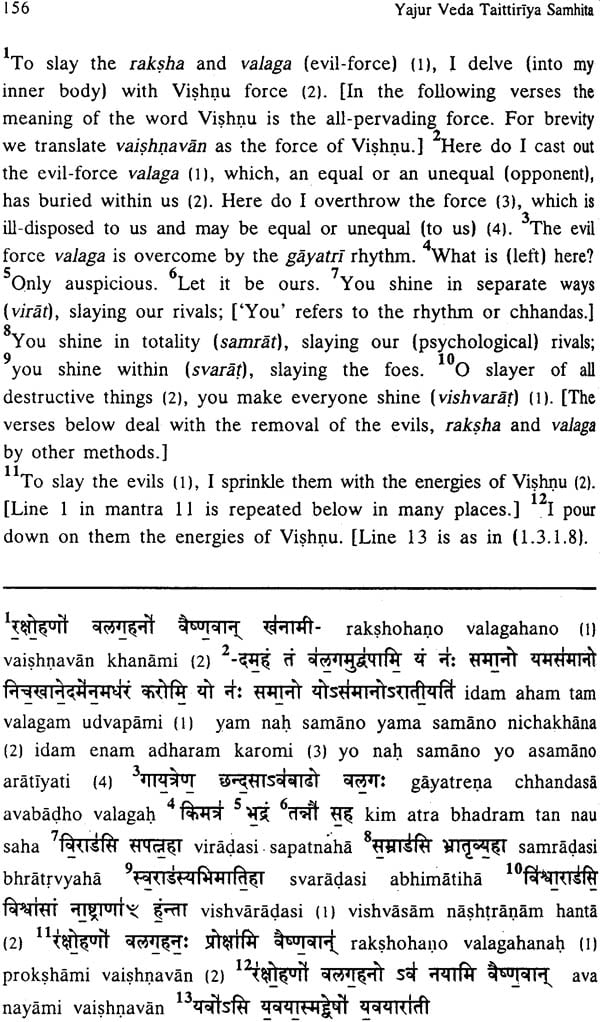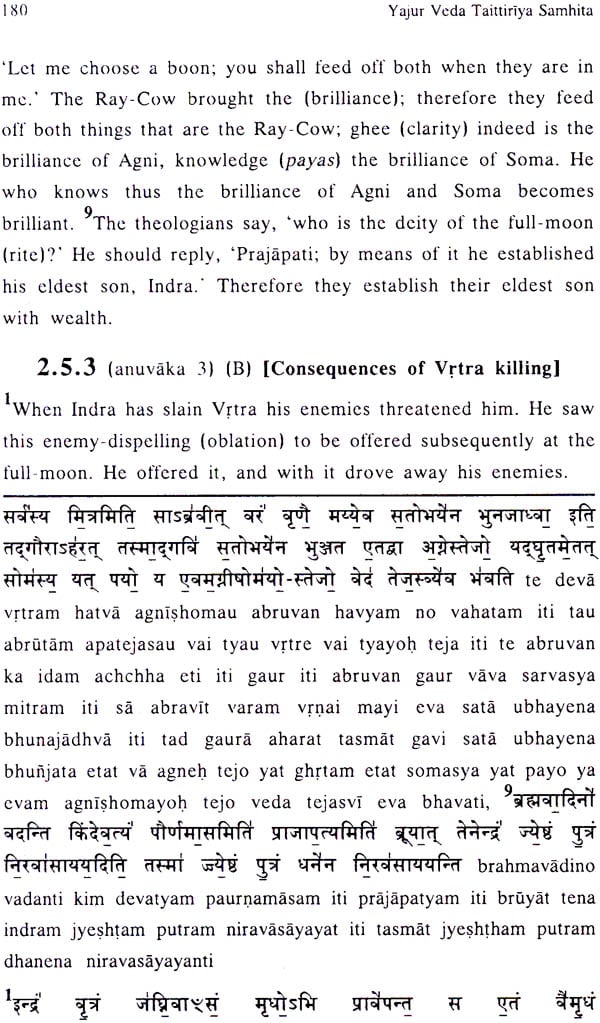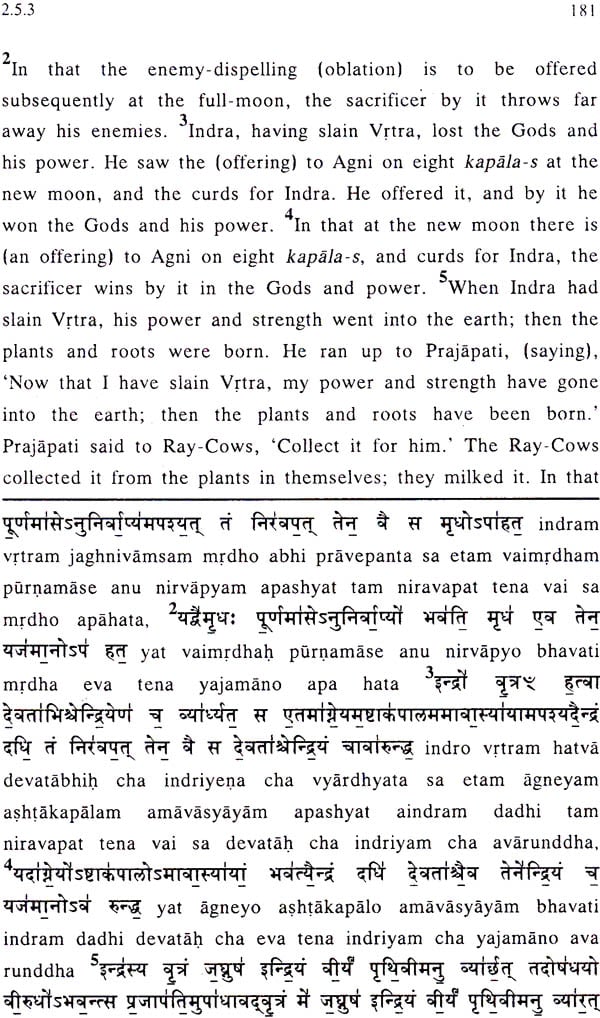
Yajur Veda Taittiriya Samhita: (In 4 Volumes) (Complete Text in Devanagari With Transliteration, English Translation and Notes)
Book Specification
| Item Code: | NAD478 |
| Author: | R. L. Kashyap |
| Publisher: | Sakshi Sri Aurobindo Kapali Sastry Institute of Vedic Culture (Bengaluru) |
| Language: | Complete Text in Devanagari With Transliteration, English Translation and Notes |
| Edition: | 2014 |
| ISBN: | 9788179940044 |
| Pages: | 2129 |
| Cover: | Hardcover |
| Other Details | 9.0 inch x 6.0 inch |
| Weight | 3.54 kg |
Book Description
Dr. R. L, Kashyap is Professor Emeritus of Electrical and Computer Engineering at Purdue University, Lafayette, Indiana in USA. He had his Master’s degree from Indian Institute of Science, l3engaluru and obtained Ph.D. from Harvard University. He is the recipient of many International awards. In 2003 he has received ‘Vedänga Vidvan’ award institited by Maharshi Sandipani VedavidyA Pritihthän (Ujjain), an autonomous body of HRD, Govt. of India.
He has authored more than 350 research articles of which 220 are published in scholarly journals and the rest were presented at conferences. He has guided above 50 doctoral students.
H has written extensively on Veda. Some of his widely read books on Veda are : ‘Rig Veda Samhita’ (12 Volumes), ‘Säma Veda’ (2 Volumesb ‘WhyRead Rig Veda’, ‘Rudra mantra-s’, Essentials of Rig Veda’, ‘Essentials of Yajur Veda’, ‘Essentials of Sama Veda’, ‘Work, Enjoyment & Progress’.
He is the Honorary Director of Sri Aurobindo Kapâli Sastry Institute f Vedic Culture, Bengaluru.
I am happy to present here the text and translation of Yajur Veda, Taittiriya Samhita, Kända one. The other 6 Kända-s are available in the other volumes, two, three and four.
My aim is to bring out the spiritual and psychological wisdom contained in the 1346 mantra-s of this Kanda. The main source for my work is the essays of Sri Aurobindo on the inner yajna in the Veda and his translations of the Rig Veda mantra-s. The luminous essays of T.V. Kapali Sästry have been very useful.
This book has also some prose passages known as Brahmapa-s, dealing with ritualistic explanations of mantras, legends and other topics. In translating these prose passages, I have utilized the English translation of A.B. Keith and the Sanskrit commentaries of Sdyaia and Bhatta Bhäskara.
The translation of the entire KYTS text has been an uphill task in view of the fact that almost everyone views it as a book of outer rituals. I am particularly grateful to Prof. S.K. Ramachandra Rao for his continuous encouragement. I am grateful to all the savants and scholars who have written luminous forewords to the three volumes upholding its spiritual interpretation namely, His Holiness Sri Sri
Rangapriya Sripda Sri Sri, Siddheshwara Swãmiji, the eminent Western scholar and spiritual aspirant Sri Rand Hicks and Professor S.K. Ramachandra Rao.
SAKSI trustees and myself offer our profuse thanks to Smt. Laxmi N. Kamath, Udupi for sponsoring the printing cost of this book. We pray to the Veda Purusha for granting excellent health and allaround happiness to the Kamath family.
My profuse thanks to the staff of SAKS) for patiently handling the numerous manuscript versions of this work.
Thanks to the printer Sri Balakrishna for his cooperation in all stages of the work. Finally my thanks to the readers of the SAKSI books for their continuous encouragement and support.
(1) There is a persistent confusion in the minds not only of ideologists but also of the students of Indian culture in general about the correct interpretations of the Vedic passages dealing with animal sacrifice. Such passages occur not so frequently in the Rig Veda Samhitã as in the Brãhmaria texts; and this is natural because the Brãhmana-texts focus their attention on rituals (karma kãntla). Rituals are of numerous types and some of them accept or prescribe violent practices like killing animals and offering parts of the slain animal as offerings (pashum ãlabheta). Some interpreters like Sayaiia, who reconcile themselves to animal sacrifices as Vedic rituals, are inclined to take the passages to mean exactly what they say, despite the general tenor of the Rig Veda respecting all life and condemning violence of any kind to animals (na himsyat sarvä bhutãni). Those who regard themselves as orthodox take Sayana as a reliable authority in Vedic matters.
This, however, is an error, and a grievous one at that. Sayaia is by no means an advocate of the true spirit of the Vedic Corpus. The Veda is important because of the high human values it upholds, and because of its relevance to all mankind and for all time. The true import of the Veda lies in its hidden teaching, the initial or rahasya. The Veda itself indicates this. We are all familiar with the acknowledgement;
The wise folk are disinclined to swallow what is apparent; they would rather get at the hidden, the mystical, the real meaning. The Veda is after all a book of mysteries. It emphasizes the distinction between appearance and reality. Sayaria has altogether ignored this; he hangs on to what appears on the surface. Pundits after him (he lived in the fourteenth century) have followed his line of thought, as if they are as authentic as the Veda-s themselves! They have led ideologists astray, and kept the common people in darkness about the true significance of the Vedic Corpus. Acharya Ananda-trrtha (Madhva-charya) in the thirteenth century struck the right note in his Rig Bhahya when he pointed out that the Vedic passages have three meanings: the common meaning referring to Gods (adhidaivika), the ritualistic import (adhi-yajfla) and more importantly the esoteric meaning (adhytmika). The great yogis Swami Raghavendra-tirtha elaborated the last of these in his Mantrartha-manjari. In recent times, it was Sri Aurobindo who insisted that the Veda is essentially a mystical text, elaborately spiritual in its connotation. His disciple, Kapli Sastry, undertook to write a commentary on the Rig Veda, highlighting the secret meanings of the Vedic passages. His attention was confined to Rig Veda Samhita.
Following his lead, Dr. R.L. Kashyap, who is well-known for his work popularising Kapäli Sastry’s contributions, has now turned his attention to applying the same methodology to other areas of the Vedic Corpus. He has brought out in English a spiritual and mystical interpretation of Taittiriya Samhitã, belonging to Krishna Yajur Veda division. This is an important undertaking, pioneering and educative.
This text is distinguished by its predominant ritualistic involvement. It is well-known among the adherents of the Karma Kända section of the Vedic protagonists; and is extensively relied upon by the priestly class, responsible for rituals of all sorts, including animal-sacrifices. It is therefore very difficult to provide mystical meanings for ritual prescriptions. Dr. Kashyap has understandably an uphill task to perform, and we are glad that he has accomplished his mission exceedingly well. It is by no means easy to turn the orthodox attention away from the ritualistic framework. The conservatives are ill-disposed towards; tical overtones; they even took at devotion with suspicion. They stick doggedly to the time-honored rituals, even if they are thoroughly incompatible with lay-life and changing times.
| (I) | Preface and Acknowledgements /td> | vii |
| (ii) | Ashirvachana (H.H Sri Rangapriya Sripada Sri Srih) | viii |
| (iii) | Foreword (1), (2)(Prof. S.K. Ramachandra Rao) | xii |
| (iv) | Benediction (Sri Sri Siddheshwar Swamiji) | xxx |
| (v) | Prologue.: Veda to Vedanta (Rand Hicks) | xxxi |
| (vi) | Overview | xxxiii |
| (vii) | Specific Contributions | xxxv |
| (viii) | Abbreviations xxxviii | xxxviii |
| (ix) | Note on Transliteration | xxxix |
| Part I: Introductory Essays | ||
| 1 | Outer Structure of KYTS | 2 |
| 2 | Yajna: Outward Rite or Inward Act? | 6 |
| 3 | Elements of Inner Yajna | 9 |
| 4 | The Deities and Other Symbols | 12 |
| 5 | Well-known Mantra-s | 18 |
| 6 | Benefits of Outer Yajna | 23 |
| 7 | Legends and their Deeper Meaning | 25 |
| 8 | The Place of KYTS among Veda Books | 29 |
| 9 | Refutation of Some Popular Misconceptions of KYTS | 33 |
| 10 | Frequently Asked Questions (FAQ) | 37 |
| Advanced Topics | ||
| 11 | Inner and Outer Yajña: Concordance | 41 |
| 12 | Inner Yajña in Brhmana Books | 44 |
| 13 | Inner yajfla in Upanishads | 47 |
| 14 | Chhandas and Stoma-s | 51 |
| 15 | Veda Mantra and Brahrnaia: The Connection | 53 |
| 16 | Krihia Yajur Veda Taittiriya Mantra-s (ArsheyaPäiha) | 57 |
| 17 | Praoa or Life-energy | 60 |
| 18 | Co-requisites in Veda Study: Shikhä, Kalpa etc. | 61 |
| 19 | Error-free and Meaningful Chanting | 63 |
| 20 | Annotated References | 64 |
| Part II: Text, Transliteration & Translation | ||
| A | How to read the text and translation | 72 |
| B | Classes of readers | 74 |
| C | Kanda 1: Overview | 75 |
| D | The 8 Prapahaka-s | |
| 1.1 | A Simple Inner Yajña | 77 |
| 1.2: | Inner Soma Yaga-I (Invoking the Divine Powers) | 117 |
| 1.3: | Inner Soma Yaga-II (Offering the Life and Organs) | 150 |
| 1.4: | Inner Soma Yaga -III (Dustribution of Soma & Conclusion) | 180 |
| 1.5: | Rekindling the Fire | 213 |
| 1.6: | Details of Inner Yajna | 251 |
| 1.7: | Vajapeya Yalna (Plenitude of the Life-Force) | |
| 1.8: | Royal Consecration (Rajasuya) | |
| Part III: Indices | ||
| 1 | Comprehensive Index - All 7 Kancla-s | 369 |
| 2 | Concordance from RV to TS | 400 |
| 3 | Concordance from TS to RV | 404 |
| 4 | Glossary | 409 |
| I | Preface and Acknowledgements | vi |
| ii | The Tree of KYTS | viii |
| iii | Challenges and Our Contributions | x |
| iv | Overview of Kãnda 2 | xv |
| v | Overview of Kanda 3 | xviii |
| vi | Overview of the Powers of the gods | xxi |
| vii | Symbolism of the Gods | xxiii |
| viii | Abbreviations | xxv |
| ix | Note on Transliteration | xxxvi |
| Part I: Kanda 2 | ||
| Text, Translation and Notes on all its 6 Prapäthaka-s with 75 anuvaka-s | 1 | |
| Part II: Kãnda 3 | ||
| Text, Translation and Notes on all its 5 Prapathakas with 55 anuvaka-s | 268 | |
| Part III: Indices | ||
| References | 419 | |
| Glossary | 420 | |
| Concordance of RV with TS | 428 |
| ( i) | Ashirvachana - H.H. Sri Rangapriya Sripada Sri Srih | v |
| (ii) | Foreword - Prof. S.K. Ramachandra Rao | viii |
| (iii) | SMhana Through Sacrifice - Rand Hicks | xvi |
| (iv) | Preface & Acknowledgements | xix |
| (v) | Abbreviations | Xxii |
| (vi) | Note on Transliteration | xxiii |
| Text, Transliteration & Translation | ||
| Kanda 4: Overview | 1 | |
| 4.1: | Developing the Aspiration (Inner Fire) | 7 |
| 4.2: | Preparing The Body for bearing the Agni | 57 |
| 4.3: | Development of Subtle Body-I | 107 |
| 4.4: | Development of Subtle Body-II | 151 |
| 4.5 | Rudra: Namaka Hymn | 193 |
| 4.6: | Maturing the Body to hold Divine Energies Ashvamedha (Anuvaka-s:7-9) | 229 |
| 4.7: | Rudra: Chamaka Hymn; Integers; Birth of Plenitude | 284 |
| References | 319 |
| 1 | Acknowledgements | viii |
| 2 | Format and users | viii |
| 3 | Abbreviations | ix |
| 4 | Note on Transliteration | x |
| I | Part I: Overviews | |
| 1 | Kanda 5: Overview | 2 |
| 2 | Kanda 6: Overview | 5 |
| 3 | Kanda 7: Overview | 5 |
| 4 | Yajna | 6 |
| 5 | Ashvamedha Sacrifice | 11 |
| 5.1 | Deeper meaning | 11 |
| 5.2 | Ashvamedha in Kanda 7 | 15 |
| 6 | Kanda 6: Some Details | 23 |
| 6.1 | Benefits | 23 |
| 6.2 | Brahmana-s | 24 |
| A | On Mantra-s | 25 |
| B | On Rites | 25 |
| C | On Symbolism | 26 |
| D | On Socety | 27 |
| 7 | Myths and Legends | 29 |
| 7.1 | Kadru- Suparna legend | 29 |
| 7.2 | Legends of mantra-s | 32 |
| 7.3 | Gods and Asura-s | 32 |
| 7.4 | Head of the Yajna is cut -off | 34 |
| 8 | Kanda 7: Some Details | 36 |
| 8.1 | The rites: (51 Anuvaka-s) | 36 |
| 8.2 | General observations or maxims | 39 |
| 8.3 | Rig Veda Mantra-s | 40 |
| 8.4 | Symbolism | 41 |
| 8.5 | Creation | 41 |
| 8.6 | Power of Matter and Mantra-s | 41 |
| 9 | Stoma Chants | 41 |
| II | Kanda 5: | |
| Text & Translation | 44 | |
| III | Kanda 6: | |
| Text & Translation | 344 | |
| Iv | Kanda 7: | |
| Text & Translation | 594 | |
| v | Appendices | |
| 1 | Numbers of Rigand Yajus mantra-s in all the Kanda-s | 835 |
| 2 | Overlap in Krishna (TS), Shukla YV (VS) and Rig Veda | 840 |
| 3 | Sri Aurobindo on Yajna' | 844 |
| 4 | Subject Index | 845 |









